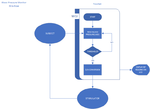baileychic
Advanced Member level 3

How to interface BP Transducer to PIC16F?
I need to use these and interface BP transducer and Analog Stimulator to PIC16F Mic rocontroller.
BP transducer needs to connect to PIC16F ADC input and Analog Stimulator needs to connect to DAC output of PIC18F.
I will be using PIC16F1779 which has both 10-bit ADC and DAC.
Find attached file.
This is for a lab experiment.
Also fins attached flowchart.
I need to use these and interface BP transducer and Analog Stimulator to PIC16F Mic rocontroller.
BP transducer needs to connect to PIC16F ADC input and Analog Stimulator needs to connect to DAC output of PIC18F.
I will be using PIC16F1779 which has both 10-bit ADC and DAC.
Find attached file.
This is for a lab experiment.
Also fins attached flowchart.









